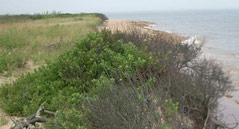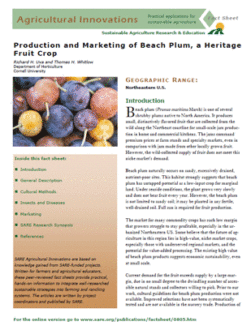Soil Preparation
Spring one year before planting
Add lime and fertilizer as specified by the soil testing service and plow it into the soil to 16 inches if possible. In general, a pH of 6-6.5 is recommended for production of most tree fruits. Incorporate lime and fertilizer into the root zone before planting. As with all perennial crops, after planting you do not get a chance to work the soil again. Dolomitic lime (lime with 10% of magnesium or more) is recommended because it raises the soil pH causing nutrients to be more available and it is also an important source of magnesium and calcium.

If needed, the addition of phosphorous before planting is important as it is relatively immobile and may not reach the root system if only applied to the soil surface. Nitrogen on the other hand is very mobile and if put on at this time will leach through the soil profile long before the plants are installed. Incorporate lime and phosphorus a year before planting. It may be desirable to re-test the soil again before planting to verify pH adjustment and nutrient levels.
Early spring of planting
At the time of planting, water in each plant with water-soluble fertilizer. As foliage develops (mid-May) apply 0.6-1.0 oz. nitrogen per tree, which is equivalent to 4 to 6 ounces of calcium nitrate or 2 to 3 ounces of ammonium nitrate to the surface of the soil (5).
Fertilization
Fertilization needs will vary with soil type and plant size. Application of fertilizer based on soil and foliar nutrient analysis can optimize crop performance by tailoring fertilizer levels to the specific needs of fruit trees. Ample growth of 1.5 feet of shoot growth during the growing season may be desirable for beach plum. Depending on soil type, fertilizer application rates will vary. Keep track of rates and measure growth every year. Young transplants may be fertilized with 0.6 to 1.0 oz. of nitrogen per tree, as foliage emerges in mid-May. On established plants, 0.1 to 0.2 pounds per tree of nitrogen applied under the drip line may be sufficient for beach plum fruit production. As nitrogen is easily leached from the soil, it should be applied under the drip line in the weed-free strip. If too much nitrogen is applied, excessive vegetative growth could occur at the expense of yield. On sandy soils, nitrogen might be best applied as split applications over two to three weeks to minimize loss due to leaching. On soils with a greater clay and organic matter content, little or no additional fertilizer may be needed once plants are established.
Pruning
Beach plums may be pruned in late winter to early spring. Remove crossed, shaded, cracked, and down-pointing branches. Diseased branches with cankers and black knot should be removed. If black knot occurs, it should be removed at least 6 inches below the gall, disinfecting the pruning shears with a 10% bleach solution in between cuts.
Maintain an open canopy to facilitate light penetration and air circulation. Keep plants at a size where picking is practical. If biennial bearing is a problem, do your heavy pruning in years where you are expecting a heavy crop. Beach plums form their fruit on the base of one-year-old wood and spur formation is uncommon. Peach also bears on annual wood and could serve as a model for pruning.
